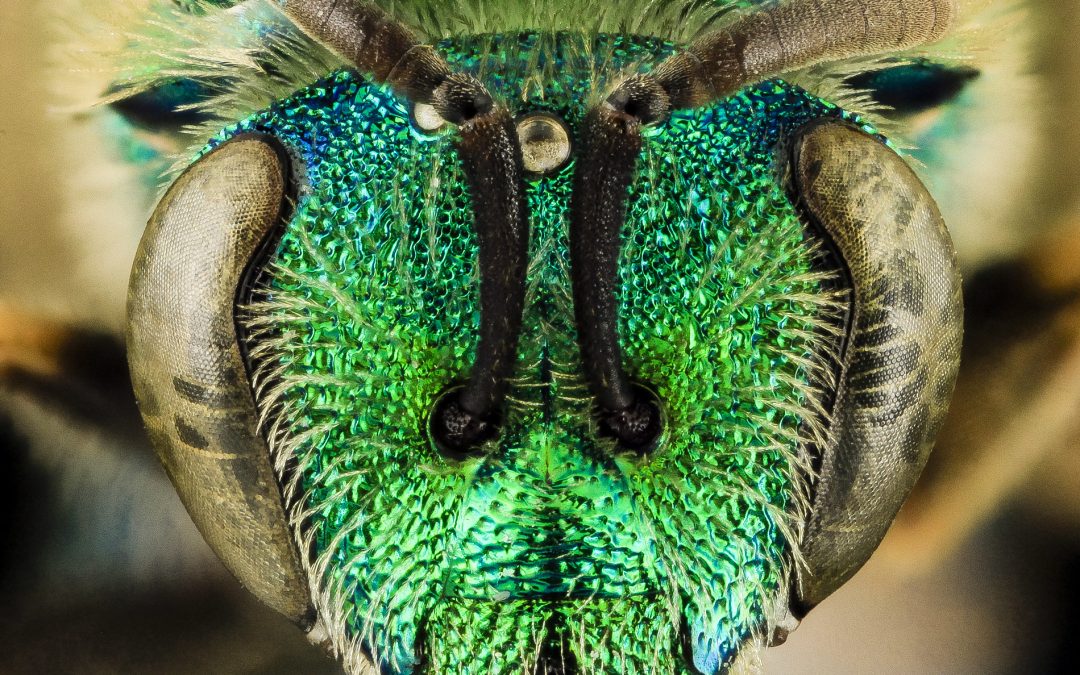
by Mark Hepner | May 14, 2019 | Mitigation & Restoration, News, Permitting, Vegetation Management |
Native Bees are Important to West Virginia
West Virginia’s native bees including bumble bees, mason bees, leaf-cutter bees, miner bees, and sweat bees are important to the pollination of most flowering trees, shrubs, and herbaceous plants within the forests and fields of the Mountain State. Therefore, our native bees are important mechanisms for feeding West Virginia’s people and wildlife. West Virginia is rich with a diversity of habitats such as large river valleys, high-elevation mountains, forests, fields, etc. that are home to a diversity of flowering plants that provide pollen and nectar for a diversity of native bees. There has been a rapid decline of bumble bee species (Bombus spp.) throughout much of North America, including some that were once common in West Virginia. This has created the need for inventories to determine the current status of all native bee species. The use of published bee research, museum specimens, and historical records coupled with field data is needed to develop a list and determine the status of West Virginia’s native bees.
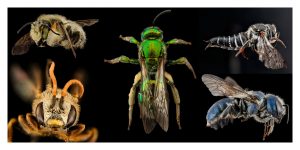 Top left: Megachile latimanus; Bottom left: Halictus ligatus; Center: Augochloropsis metallic; Top right: Coelioxys sayi; Bottom Right: Osmia texana
Top left: Megachile latimanus; Bottom left: Halictus ligatus; Center: Augochloropsis metallic; Top right: Coelioxys sayi; Bottom Right: Osmia texana
Surveying West Virginia’s Native Bees
In 2018, AllStar Ecology began coordinating with the U.S. Fish and Wildlife Service (USFWS), West Virginia Division of Natural Resources (WVDNR) and U.S. Geological Survey (USGS) to document West Virginia’s native bees. The WVDNR, the U.S. Department of Agriculture’s Forest Service (USFS), West Virginia State Parks, and private landowners granted permission for AllStar Ecology personnel to survey native bees on lands under their ownership and management. Four AllStar Ecology Environmental Scientists conducted 242 native bee surveys using hand nets within 45 of the 55 West Virginia counties that resulted in the collection of 6,377 bees. These surveys identified 124 species including a new location of the rusty-patched bumble bee (Bombus affinis), which is currently on the USFWS’s Endangered Species List (List). The male was discovered in Tucker County and with a rare color pattern. The yellow-banded bumble bee (Bombus terricola), a candidate species to be placed on the List was found at eight locations, representing the first records of this species in West Virginia since 1979. Also found were 16 species of specialist bees, which are species that only collect pollen and nectar from a specific plant species or plant group. Four species of the located specialist bees are considered to be rare. Three species that were not previously recorded in West Virginia were discovered, including a cuckoo bee (Nomada graenicheri), leaf-cutter bee (Heriades leaviti), and mining bee (Andrena illinoiensis) in Ritchie, Mingo, and Lewis Counties, respectively. This initial data is useful in determining which bee species are common and help to determine the distributions of rare, threatened, and endangered bee species. Future surveys will likely discover new species records for the state and additional locations of rare, threatened, and endangered native bee species. Click here to view the 2018 rusty-patched bumble bee collected in Tucker County, WV along with other WV native bees on the USGS Native Bee Monitoring and Inventory Lab’s Flickr page.
 Bombus affinis Bombus terricola Heriades leavitti
Bombus affinis Bombus terricola Heriades leavitti
West Virginia, a Mountain Refuge
The rusty-patched bumble bee found in 2018 is the second to be documented within West Virginia since the 1990’s. This is encouraging that there are additional areas where the species is finding refuge within the Mountain State. The West Virginia locations, along with locations found in western Virginia over the last few years, are the only locations where the rusty-patched bumble bee is being found east of Illinois. The USFWS has a rusty-patched bumble bee map that shows the areas where the species has been found in recent years. Click here to view USFWS map.
The rediscovery of yellow-banded bumble bees in WV is also encouraging. All eight locations where yellow-banded bumble bees were recorded are within the USFS Monongahela National Forest and occur in high-elevation habitats, averaging close to 4,000 feet above sea level.
Native Bee Pollinator Awareness
With the importance of native bees to the health and well-being of West Virginia’s people and wildlife, an effort is being made by AllStar to share the data and knowledge gained from these surveys with scientists and the general public. Mark Hepner is leading this effort and has presented about West Virginia’s native bees to community groups and organizations, encouraging everyone to learn about our native bees and to provide habitat wherever possible. A key point of Mark’s message is the need to provide flowers, native flowers are best, throughout the spring, summer, and fall. This is something most West Virginian’s can provide for our native bees by mowing less frequently or not mowing certain areas to allow flowers to bloom. The more we can learn about West Virginia’s native bees, the better we can understand the role they play in pollinating our forests and fields to help keep our state Wild and Wonderful.
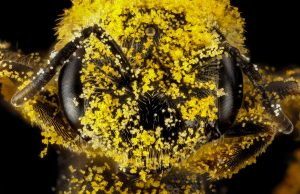 Halictus ligatus
Halictus ligatus
Useful Native Bee Resources
- Colla, S., L. Richardson, and P. Williams. 2011. Bubble Bees of the Eastern United States
- Discover Life, https://www.discoverlife.org/20/q?search=Apoidea
- The Very Handy Manual: How to Catch and Identify Bees and Manage a Collection. 2015.
- U.S. Department of Agriculture, Natural Resources Conservation Service, WV Division of Natural Resources, and The Xerces Society for Invertebrate Conservation, 2012. West Virginia Pollinator Handbook. A Field Office Technical Guide Reference to management of pollinators and their habitats.
- USGS Bee Inventory and Monitoring Lab | Flickr, https://www.flickr.com/photos/usgsbiml/
- Williams P., Thorp, R., Richardson, L., and Colla, S. 2014. Bumble Bees of North America: An Identification Guide. Princeton University Press.
- Xerces Society of Invertebrate Conservation, http://www.xerces.org
References
- U.S. Department of Agriculture, Natural Resources Conservation Service, WV Division of Natural Resources, and The Xerces Society for Invertebrate Conservation, 2012. West Virginia Pollinator Handbook. A Field Office Technical Guide Reference to management of pollinators and their habitats.
- Cameron S., J. D. Lozier, J. P. Strange, J. B. Koch, N. Cordes, L. F. Solter, and T. L. Griswold. 2011. Patterns of widespread decline in North American bumble bees. Proceedings of the National Academy of Sciences 108(2):662-667.
- Evans E., R. Thorp, S. Jepsen, and S. H. Black. 2008. Status review of three formerly common species of bumble bee in the subgenus Bombus.
- Fowler, J. Host plants for specialist bees of the Mid-Atlantic and Northeastern United States. http://jarrodfowler.com/host_plants.html
- Fowler, J. and S. Droege. Specialist bees of the Mid-Atlantic and Northeastern United States. http://jarrodfowler.com/specialist_bees.html
- McKinney M. Bee Natural History, Diversity, and Management in West Virginia. Dissertation submitted to the Davis College of Agriculture, Natural Resources, and Design at West Virginia University, Morgantown, West Virginia 2016.
- Schweitzer D. F., N. A. Capuano, B. E. Young, and S. R. Colla. 2012. Conservation and management of North American bumble bees. NatureServe, Arlington, Virginia, and USDA Forest Service, Washington, D.C.
- Williams P., Thorp, R., Richardson, L., and Colla, S. 2014. Bumble Bees of North America: An Identification Guide. Princeton University Press.
- Ascher, J. S. and J. Pickering. 2018. Discover Life bee species guide and world checklist Hymenoptera: Apoidae: Anthophila). http://www.discoveerlife.org/mp/20q?guide=Apoidae_species
- The Very Handy Manual: How to Catch and Identify Bees and Manage a Collection. 2015.
- USFWS Rusty-patched bumble bee webpage. https://www.fws.gov/midwest/endangered/insects/rpbb/index.html
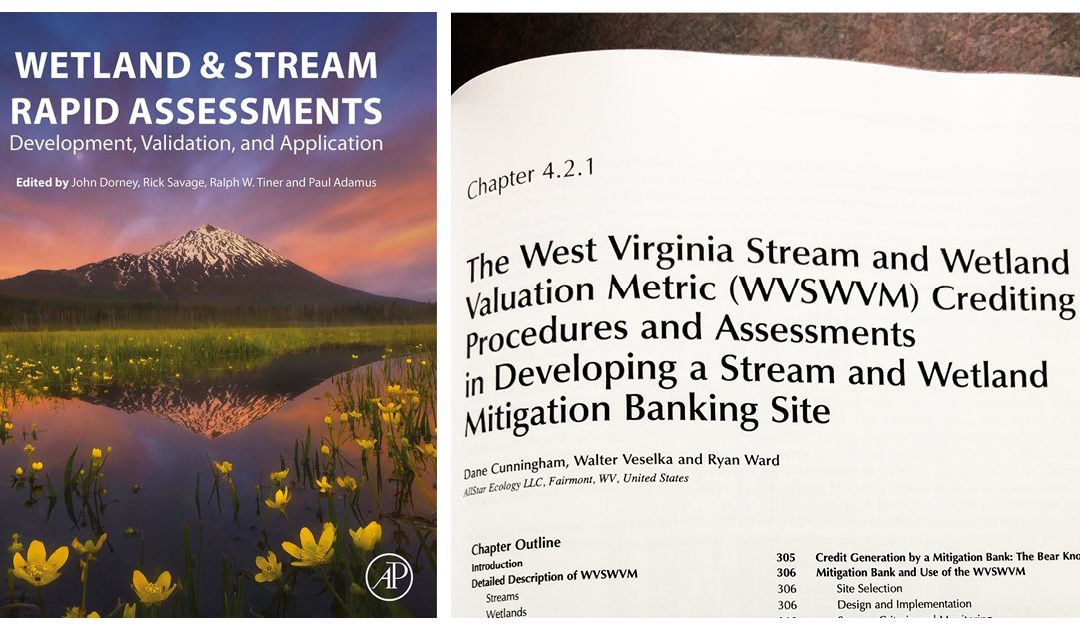
by Derek Springston | Mar 27, 2019 | Mitigation & Restoration, News, Stream & Wetland Permitting
AllStar Ecology recently authored a chapter in the professional book Wetland and Stream Rapid Assessments: Development, Validation, and Application. This book describes the scientific and environmental policy background for rapid wetland and stream assessments, how such assessment methods are developed and statistically verified, and how they can be used in environmental decision-making—including wetland and stream permitting.

AllStar Ecology’s Dane Cunningham, Walter Veselka, and Ryan Ward co-authored Chapter 4.2.1 – “The West Virginia Stream and Wetland Valuation Metric (WVSWVM) Crediting Procedures and Assessments in Developing a Stream and Wetland Mitigation Banking Site”. This chapter details the assessment methodologies that comprise the WVSWVM, use of the metric, and the framework for using with regard to mitigation banking. AllStar Ecology takes pride in being a leader in environmental consulting and research, with employee’s specialties ranging from aquatic entomology to stream/wetland restoration design and construction.
To learn more about our Mitigation and Restoration Services team, visit our Mitigation and Restoration page.
To learn more about our Stream and Wetland Permitting team, visit our Stream and Wetland Permitting page.
To read more about AllStar Ecology, visit our About Us page
TALK WITH US
Thanks for reading,
AllStar Ecology
info@allstarecology.com
304-816-3490

by ALLSTAR | Mar 11, 2019 | Aquatic, News
In 2016, two species of Appalachian crayfish, the Big Sandy Crayfish (Cambarus callainus) and the Guyandotte River Crayfish (C. veteranus) were awarded federal protection under the Endangered Species Act. Due to their limited range and degrading habitat, the Big Sandy Crayfish was designated as a threatened species and the Guyandotte River Crayfish was designated as an endangered species. These designations provide each species protections through United States Fish and Wildlife Service (USFWS) management and oversight of activities which may alter species distribution and/or habitat.
The Big Sandy Crayfish (C. callainus) was first observed in 1937 and is only known from the Big Sandy River watershed in eastern Kentucky, southwestern Virginia, and southern West Virginia. More specifically, it is only found in McDowell and Mingo Counties within West Virginia. The Big Sandy Crayfish is currently considered threatened because of its potential to become endangered if populations continue to decline in number and habitats continue to become limited.
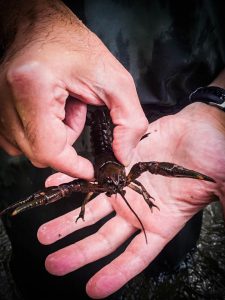
Cambarus callainus
The Guyandotte River Crayfish (C. veteranus) is currently only known to occur in two streams of its historic range in Wyoming County, West Virginia. The species has a well-known population in Pinnacle Creek and a recently found population in Clear Fork. The Guyandotte River Crayfish is considered to be endangered because known populations are small and are isolated from each other. This makes the species vulnerable to die-offs as result of single pollution events and lack of genetic diversity.

Cambarus veteranus
Both species are habitat specialists, meaning they have specific habitat requirements for the establishment and success of their populations. Large slab boulders within swift moving creeks and streams are the preferred refugia for both species. Unfortunately, these habitats can become increasingly scarce as a result of increased sediments to streams such as sand and silt. In addition, historic industrial activities and poor infrastructure in the region have also resulted in water quality issues throughout each species’ historic range.
With habitat availability declining, these two-protected species are forced to compete with common native crayfish species for resources and refugia. Interspecies competition can further inhibit the likelihood of their success.
Crayfish Presence/Absence Surveys
AllStar Ecology has a team of aquatic biologists who conduct threatened and endangered crayfish surveys in the southern coalfields of West Virginia, Virginia, and beyond. With multiple staff members having passed identification and survey protocol testing, AllStar Ecology can deploy teams of aquatic biologists to conduct the necessary surveys.
Over the past two years, our biologists have conducted numerous presence/absence surveys in McDowell, Logan, and Wyoming Counties, West Virginia for bridge enhancement projects and utility lines. Due to the instream work associated with these projects, the surveys were necessary to avoid potential disturbance to endangered crayfish and their habitats.
Having previously worked with federal and state agencies on threatened and endangered crayfish surveys, AllStar has the experience and knowledge to develop survey plans and conduct the necessary surveys to fulfill the needs of your project. Learn more about all of our services by clicking here or contact us for more information.


by Derek Springston | Feb 20, 2019 | News, Volunteerism
Overview
AllStar Ecology’s Employer Sponsored Volunteer Program encourages our employees to serve and support our local and regional communities through volunteerism efforts. In 2018, seventeen of our employees (nearly half of our staff) participated in the program, represented AllStar, and provided over 188 hours of community service. We conducted educational outreach at local universities, high schools, and youth groups and also provided environmental surveys, tree plantings, church volunteerism, and local non-profit assistance.
Educational Outreach
In 2018, six AllStar employees volunteered their time at local schools and organizations to educate and teach children, young adults, college students, and school administrators about the environment and how our work relates to it. Participants learned about topics including stream channel design, sediment removal, fish relocation, environmental permitting, agency coordination, electrofishing, bee habitat and surveying, and underwater archaeology.
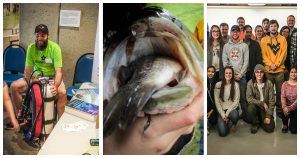
Environmental Surveys
AllStar Ecology’s staff has a wide variety of experience and education in numerous environmental consulting fields, which allows us to provide expertise to support local and regional community groups and agencies with a broad range of tasks related to environmental surveys. In 2018, an AllStar Ecology Environmental Scientist assisted the West Virginia Division of Natural Resources with rattlesnake surveys at Coopers Rock State Forest. They confirmed the presence of one timber rattlesnake, which was captured, processed, marked, and released in an ongoing effort to monitor the health and distribution of the species in the area.
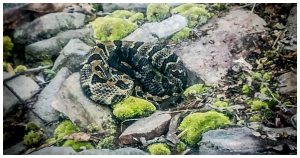
Community Service
In 2018, several AllStar employees volunteered with numerous boards, churches, and other non-profits to provide a variety of assistance to our local communities including distribution of winter clothing to those in need, riparian tree plantings for Trout Unlimited to increase riparian habitat along restored reaches of trout stream, and support of Positive Spin who aims to make bicycles more available to community members.
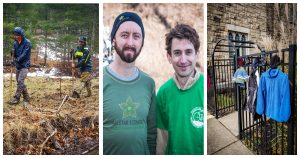
Project Highlight – Robert C. Byrd High School
In 2018, AllStar provided environmental permitting guidance to Robert C. Byrd High School in Clarksburg, West Virginia, for their proposed Ecological Park Project. The project involved removing accumulated sediment within an existing stormwater pond located on the school’s property. AllStar completed all applicable environmental permitting including coordination with the United States Army Corps of Engineers and West Virginia Department of Environmental Protection. Prior to dredging the pond, AllStar worked with Junior ROTC members of Robert C. Byrd High and graduate students within WVU’s Wildlife and Fisheries Resources Program to safely electrofish, identify, measure, and relocate fish previously residing within the pond to another nearby pond with suitable habitat.

To read more about AllStar Ecology, visit our About Us page.
TALK WITH US
Thanks for reading!

by Ryan Ward | Apr 13, 2018 | Bat Services, News
AllStar Ecology was well represented at the Joint Bat Working Group Meeting in Roanoke, VA. The March 27-29, 2018 meeting was an assemblage of the Northeast Bat Working Group, Midwest Bat Working Group, the Southeastern Bat Diversity Network, and the Colloquium on the Conservation of Small Mammals.
Malachia Evans, AllStar Ecology Bat Biologist, presented a poster on the use of AllStar Ecology artificial roosting structures by northern long-eared bats. Bats utilized 73% of the sites where AllStar installed roosts and rocket boxes saw a 24% increase in use during their second year on the landscape. AllStar’s landscape modeling also showed to be a useful tool for roost placement. Click here to download Malachia’s poster: Artificial Roost Use by Northern Long-Eared Bats in West Virginia from 2016-2017 – Malachia Evans & Eric Schroder (pdf)

Neil Lafleur, AllStar Ecology Bat Biologist, presented a poster on his development of a bag trap to catch bats utilizing AllStar built rocket boxes. Neil’s trap design boosted our catch rate of bats monitored in rocket boxes from 60% to 94%.
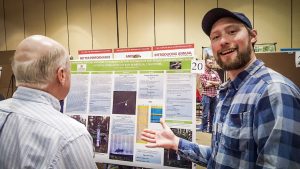
Jesse De la Cruz, former AllStar Ecology Bat Biologist, is now with the Conservation Management Institute out of Virginia Tech. Jesse gave an oral presentation on roost use by northern long-eared bats which represented work he conducted with AllStar and further research with CMI.

Eric Schroder, AllStar Ecology Bat Biologist, gave an oral presentation on recently published research on Indiana bats from his Masters thesis work at Western Illinois University. Click here to download Eric’s article and presentation: Indiana bat maternity roost habitat preference within Midwestern United States upland Oak-Hickory forests – Eric Schroder (pdf); Indiana Bat Maternity Roost Preference within Midwestern United States upland Oak-Hickory Forests – Eric Schroder (pdf)

Philip Arant, new AllStar Bat Biologist, gave an oral presentation of work he recently completed for his Masters thesis at the University of Kentucky. Philip will continue to help with this research into forest management techniques and the effects on northern long-eared bats in his new role with AllStar.

Ryan Ward, Senior Environmental Scientist/AllStar Ecology Owner, gave an oral presentation on AllStar’s development of conservation sites for rare, threatened, and endangered bats. He covered site selection and various conservation measures such as artificial roosts, potential roost tree creation, reforestation, and hibernacula protection.
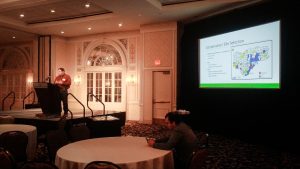
For information on topics related to our bat program and the upcoming bat season, please contact Eric Schroder at 304-816-3490.

by Charity Moore Norton | Apr 2, 2018 | Cultural Resources, News
The Naming of Rover’s Run and Bear Knob
At the western edge of Upshur County lies a small perennial stream called Rover’s Run. This stream derives its name from a case of mistaken identity, according to Lucullus Virgil McWhorter, an amateur archaeologist, author of a 1915 book on the history of Hacker’s Creek, and later Western pioneer who grew up nearby. McWhorter describes his grandfather and a friend’s (John Edmonds) hunting trip. As they traveled through the unbroken forest, Mr. Edmonds spied a wolf off in the distance. After taking the shot, he approached the dead animal, only to find that he had killed his favorite dog, Rover.
Like the rest of the Hackers Creek watershed, this stream runs through a deep valley surrounded by steep, narrow ridges. One of the overlooking ridgetops, which also happens to be the tallest point in the watershed, is identified on old maps as “Bear Knob.” This name comes from another hunting anecdote from the mid-1800s, also recorded by McWhorter. After a hog was taken from a farm, Isaac Reger took a rifle and hunting dogs to track down the offending bear. His dogs chased the bear into a tree on the tall knob, allowing Mr. Reger to take his revenge. The knob had formerly been known as “Potato Knob,” due to its profile’s similarity to a potato mound, and later became a popular site for Easter parties.
The Role of Archaeology and History
Although McWhorter is considered to be a reliable source, his information is based on oral tradition. This is often the case in local history, which mixes hearsay, “fish stories,” and half-remembered events that are much more colorful than the dry government records and genealogies that scholars use to research the past. While we may never know where Rover actually died, or if a hungry bear was really a defining local moment, archaeology can give us a science-based look into the everyday lives of past individuals. History can tell us Mr. Smith lived in the year eighteen-something, but archaeology can tell us that he had a habit of smoking with a horn pipe and that his wife bought her dishes from the city instead of the local general store. On a bigger scale, archaeology can answer questions about socio-economic status, farmstead layout, and other topics that don’t always make it into written records.

Phase I and II Survey Results
In November 2014, AllStar Ecology began an archaeological survey of the Bear Knob Property, which includes both Rover’s Run and Bear Knob. A total of 738 artifacts were collected, including Native American tools and pottery, a horseshoe, possible lead shot, and fragments of dishes and bottles from early European-American settlers. These artifacts belonged to 12 different archaeological sites and may span as much as ten thousand years, providing a unique look at human history within a single West Virginia valley. These resources included isolated lithics, scatters of prehistoric artifacts, historic-period debris scatters associated with old houses, and a group of interesting rock piles.

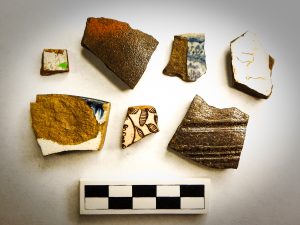
Historical Research Results
As AllStar Ecology’s Archaeologists began to study the artifacts and relate them to historical documents, the story of an early West Virginia family began to emerge. Instead of just reading about the Lawmans, Bonds, and other inhabitants of the hollow, we were holding the physical representations of their lives and actions. According to a descendant, William Lawman and his father Barnhard built a log cabin at the head of Rover’s Run in the 1860s, matching the interpretations of survey findings. Along with an older brother, William fought for the Union during the Civil War, while Barnhard and his 10-year-old son fought for the Confederacy. The latter two moved to a neighboring hollow after the war and a path between the two is visible in aerial imagery. The remains of their homes were studied and can contribute to our understanding of daily life during this difficult period in history.
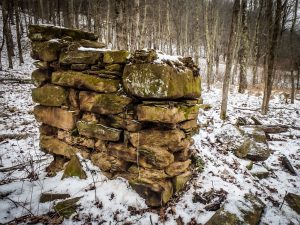
The Future of the Bear Knob Property
Many of the identified cultural resources will be preserved within an aquatic resource mitigation bank to be constructed on the property, which will allow for their future access by archaeologists, perhaps as part of mitigation for another project. The Bear Knob Property survey was a unique experience for AllStar Ecology, as it uniquely shed light on the history of an entire hollow and provided an example of how cultural resource management can benefit from mitigation banking.

 Top left: Megachile latimanus; Bottom left: Halictus ligatus; Center: Augochloropsis metallic; Top right: Coelioxys sayi; Bottom Right: Osmia texana
Top left: Megachile latimanus; Bottom left: Halictus ligatus; Center: Augochloropsis metallic; Top right: Coelioxys sayi; Bottom Right: Osmia texana Bombus affinis Bombus terricola Heriades leavitti
Bombus affinis Bombus terricola Heriades leavitti























